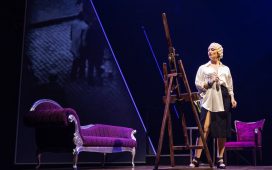Kai Althoff has been the enfant terrible of German painting for almost quarter of a century. It is a curious pose for a man in his middle 50s, but his shows are still designed to bemuse and provoke. Althoff is both as good and as bad as he wants to be, showing the cack-handed alongside the accomplished, the dumb against the tender, the delicate gouache beside the cruddy oil, sometimes painted on what look like chunks of old carpet. He never wants your eye to settle.
Born in 1966, in Cologne, Althoff gave up art school to run a bar, co-found a band and produce dance music in the 90s. He gained early notoriety from peeing on a series of his own canvases before they were sold. This acute ambivalence persists, notably in a letter he wrote to his agent in 2012 explaining that he wasn’t showing anything at the international Documenta show because life had intervened. The letter, needless to say, became the exhibit.
At the Whitechapel Gallery, Althoff presents hundreds of works, mostly the images for which he is best known – pairs and groups of figures, painted in a kind of retro-pastiche that runs all the way back to German Expressionism and before. A Prussian soldier plucks at his toppling comrade and the flattened shapes are pure fin de siècle. A father embraces his son – or is it more like restraint? – and the draughtsmanship is flawlessly classical.
There is a vein of late-flowering symbolist whimsy; palely loitering lovers and haloed silhouettes that might make you think of Simeon Solomon. There are tormented scenes out of Otto Dix and George Grosz and here and there the kind of flying postman folkishness of Marc Chagall. It feels like the visual equivalent of ventriloquism, except that the artist declares his own presence in the jostle. That it is impossible to pin down his idiom or style becomes the point.
In the early years, there seems to be a lot of implied narrative, often depicted in felt-tip or coloured pencil. Three large drawings appear in sequence. A youth in a German hat takes a train journey, with rustic views through the window; a brawnier young man assumes a mysteriously aggressive pose; a third appears in a bakery, with a batch of fresh bread, giving a “Heil Hitler” salute. They seem to belong to some dark and knotted myth of origin; how the innocent young traveller turned into the baker.

Yet the meaning is deferred. And it is not at all clear that the numerous depictions of Orthodox Jews in New York’s Crown Heights, where Althoff has lived since 2009, are observations, dreams or something approaching myth as well. One image, made using coloured pencil and blueberries, presents a girl in a red dress stricken with a heightened but indecipherable emotion while the foreground is filled with the close-up face of a Hasidic man with an equally indecipherable object emitting from his mouth. It has the force of shock, arriving without source or explanation.
There is a lot of colour, sometimes strong, sometimes dilute, but always in the minor key. Althoff is drawn to shadow, weak tone and melancholy browns. The artificially lowered ceiling in the downstairs gallery looks like the roof of a greenhouse, scattered with dirt and leaves, so that you seem to be looking up at autumn.
No matter that you might be drawn into a particular picture – a disarming scene, an inscrutable relationship – the overwhelming experience is of the sheer, pressing quantity. The pictures crowd together, some of them hung two or three deep, flowing incontinently up the stairs, shifting from paper to canvas to revolting polyester, sometimes peeling off the surface like burned skin, sometimes hanging from the frame like old curtains.
This is such a dramatic gambit. It invites you to browse, but also to walk on by. You could call it an environment and people have also reached for the obvious art-world cliche of Gesamkunstwerk – or total work of art. But mainly it feels merely contrarian. How could you care about, still less pay attention to, every single work, no matter that some are surpassingly strange? Does the artist even want it?

It is not obvious what, if anything, all this has to do with the celebrated English artist-potter Bernard Leach (1887-1979). But one gallery is devoted to what amounts to a condensed retrospective, arranged by Althoff, of Leach’s extraordinary work: tiles and buttons, cups, plates and urns in that pioneering east-west fusion of his, whereby a little brown jug is both as traditional as English ale and yet somehow turning Japanese.
The connection drawn between the two artists, at least in the awestruck gallery handout, centres on mysticism. Some viewers may find this strain in both. But there is a great distance between Leach’s lifelong endeavour and the peculiar art of Althoff, which veers all the way from fey to irascible to exquisitely singular – but remains always, and wilfully, variable.
The Whitechapel Gallery also has a small anthology of works selected by the painter Gary Hume from the Hiscox Collection of art – Keith Coventry’s bronze cast of a broken sapling, Nan Goldin’s photograph of a peeling bathroom in which she appears like a pale moon in the mirror.
On the ground floor, there is a completely enthralling son-et-lumière by the Indian artist Nalini Malani. Projected against the brick walls of a vast gallery are nine projectors hurtling through almost 90 short animations. These emerge, flicker and vanish in a matter of seconds, so rapidly that it is almost impossible to fix upon their vision of life. Except that many tell of desperate stories – of “honour” killings and the brutal rape of an Indian child, of Covid-19 and the global political crises.

The effect is devastating: the world hurtling onwards, exactly as it does. Yet the animations, drawn on an iPad, flash up in marvellous line and glowing colour, before melting away with a magical incandescence. And somewhere in the background, like an underwater river, is the voice of the artist herself, reciting the fail-better urgings of Samuel Beckett and the insurgent exhortations of Bertolt Brecht.
Star ratings (out of five):
Kai Althoff Goes With Bernard Leach ★★★
Nalini Malani: Can You Hear Me? ★★★★








